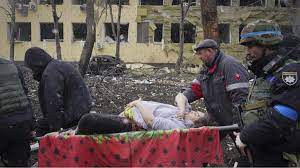
The visceral documentary “20 Days in Mariupol,” about Russia’s early assault on the Ukrainian city, will soon reach its widest audience yet.
The 94-minute film, a joint production by The Associated Press and PBS “Frontline,” has been met with critical acclaim and an audience award at the Sundance Film Festival. AP journalist Mstyslav Chernov directed the movie from 30 hours of footage shot in Mariupol in the opening days of the war. Chernov and AP colleagues Evgeniy Maloletka, a photographer, and producer Vasilisa Stepanenko were the last international journalists in the city before escaping.
“I thought I should do something more. I should do something more with that 30 hours of footage to tell a bigger story and more context to show the audience of the scale,” Chernov has said.
WHERE CAN I WATCH ‘20 DAYS IN MARIUPOL’?
“Frontline” episodes are also available after they air on the PBS app, which also includes other ways to purchase them.
WHAT SHOULD I KNOW ABOUT THE FILM?
It is an intense account of the war’s early days. Death abounds. Chernov, Maloletka and Stepanenko documented fighting in the streets, the crushing strain on Mariupol’s besieged residents and attacks that left pregnant women, children and others dead.
The trailer provides some sense of difficult scenes in the film.
WHAT ARE CRITICS SAYING ABOUT ‘20 DAYS IN MARIUPOL’?
The film has gotten excellent critical reception and won numerous awards, including two Critics Choice honors this week. It currently has a 100% rating on the film review aggregator Rotten Tomatoes.
“Watching Chernov’s film is a humanitarian duty,” Harper’s Bazaar said.
The film is also a New York Times Critic’s Pick, with reviewer Jason Farago noting: “This film is very hard to watch, and so it should be, though its episodic structure makes it somewhat easier to endure.”
“What comes through most vividly, other than the human tragedy on display, is the vital importance of war correspondents and the courage and ingenuity they must possess in order to work under such life-threatening conditions,” The Hollywood Reporter said in its review.
HOW DID THE FILM COME TOGETHER?
Chernov and the AP team could only send limited footage and dispatches during their 20 days in Mariupol.
Once they were safely outside the city, the team was able to review their footage and Chernov considered what to do with it. He wanted to focus on the time the team was in the city and narrated the film himself.
“It’s OK to tell the audiences about your emotions,” he said. “It’s just important to not let those emotions dictate what you show and don’t show. … While narrated by me, I still tried to keep it fair.”
“Frontline” producer Michelle Mizner edited “20 Days.”
WHERE CAN I LEARN MORE ABOUT THE REPORTING BEHIND THE FILM?
Chernov’s first-person account of fleeing the city — with Russian soldiers hunting for the AP team — tells the amazing backstory behind their reporting.
For months after leaving Mariupol, the AP team continued to document the conflict in Mariupol, including a detailed investigation into a Russian attack on a theater that killed an estimated 600 civilians and Russia’s efforts to scrub the city’s identity after taking control of it.
The team, which included investigative correspondent Lori Hinnant, won the Pulitzer Prize for public service. The Pulitzer website includes links to the team’s stories and videos. AP’s coverage of the war, in Mariupol and beyond, also won the breaking news photography Pulitzer this year.
AP and “Frontline” also produced a project tracking potential war crimes, including two short documentaries that can be found on PBS’ site.





